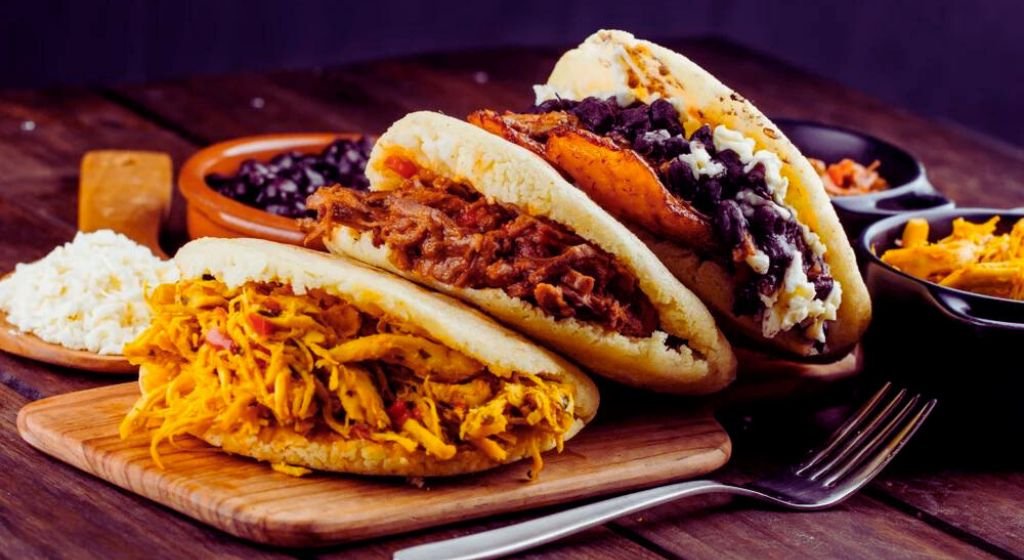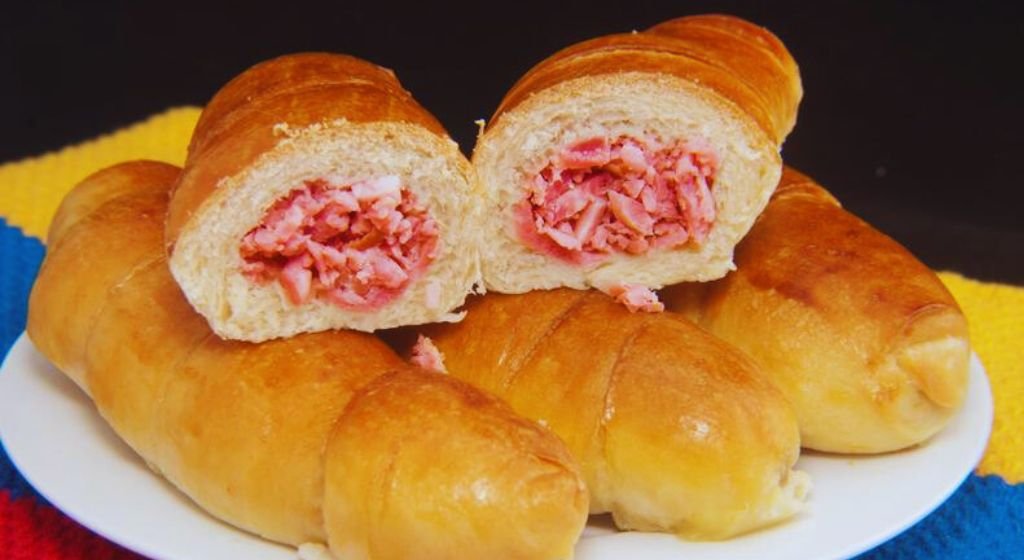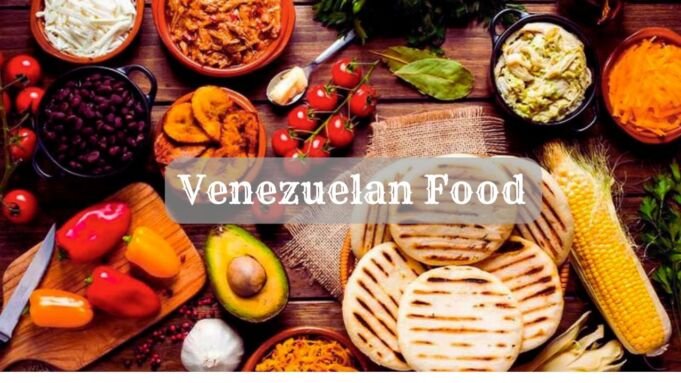Venezuelan food a vibrant tapestry woven from the diverse landscapes and cultural heritage of the country, stands as a testament to the rich history and the bountiful nature of Venezuela.
From the Andean highlands to the Caribbean coast, each dish tells a story of indigenous traditions, European influences, and African heritage, creating a unique culinary identity that is both rich in flavor and tradition.
What is Venezuelan Food?
Venezuelan food is a colorful and varied feast, enriched by culinary influences from Spain, Portugal, Italy, and France, alongside West African and Indigenous traditions, offering an enchanting experience for any food enthusiast.
The foundation of Venezuelan dishes is built on corn, rice, plantains, beans, and yams, accompanied by a variety of meats. Corn-based dishes, such as arepas, and bread are staples, frequently accompanying meals.
Additionally, Venezuelan food is known for its extensive variety of white cheese, and queso blanco, which varies in name across different regions, adding a unique touch to its culinary landscape.
Staple Ingredients in Venezuelan Cooking
At the heart of Venezuelan dishes are foundational ingredients like corn, black beans, plantains, and rice, which create the backbone of many traditional meals. Tropical fruits add a burst of sweetness and acidity to the cuisine, while a variety of meats, from beef to seafood, reflects the country’s vast biodiversity.
How Healthy Venezuelan Food Is?
Venezuelan cuisine isn’t just a feast for the senses; it’s also a friend to your well-being, offering a nutritious blend along with its culinary delights. As you embark on this gastronomic journey, keep in mind a couple of things.
Freshness is at the core of Venezuelan dishes, from corn to fruits and vegetables, promising an authentic taste adventure. And for those avoiding gluten, the presence of Arepas is a welcome sight.
Proteins are crucial in Venezuelan meals, as seen in Pabellón Criollo, which combines protein, vitamins, and carbohydrates in a satisfying mix of beef, beans, rice, and plantains.
However, moderation is key, especially with deep-fried favorites like Tequeños and Empanadas, and sugary drinks like Chicha, which can be heavy on calories due to condensed milk.
In essence, Venezuelan cuisine offers a harmonious balance of nutrition and taste. For those aiming for a balanced diet without compromising on flavor, embracing variety is essential.
Related: Turkish Foods
Iconic Venezuelan Dishes
- Arepa, Venezuela’s beloved national dish, is a versatile cornmeal cake that can be grilled, baked, or fried and stuffed with myriad fillings, making it a staple at any Venezuelan table.
- Pabellón Criollo, a plate rich in flavors and history, combines shredded beef, black beans, rice, and fried plantains, symbolizing the country’s multicultural fabric.
- Cachapa brings out the sweet side of corn in a pancake-like dish, often filled with cheese, offering a delightful contrast between the sweet corn batter and the savory filling.
- Tequeños, cheese sticks wrapped in a doughy shell, reign supreme as the go-to snack for celebrations and gatherings, beloved for their crispy exterior and gooey center.
- Hallaca, the Christmas season’s highlight, showcases the art of Venezuelan cooking with its corn dough filled with a stew of meats and capers, wrapped in banana leaves, and boiled to perfection.
25 Most Popular Venezuelan Foods

A flavorful journey through the heart of Venezuela with our guide to the 25 most popular Venezuelan foods. From the iconic arepas that serve as the cornerstone of Venezuelan cuisine to the rich and comforting Pabellón Criollo, each dish tells a story of cultural heritage, regional diversity, and culinary innovation.
Savor the sweet, the savory, and the refreshingly tropical as we explore the delicacies that define Venezuelan dining, showcasing gastronomy that is as vibrant and diverse as the country itself. Whether you’re a food enthusiast eager to expand your palate or simply curious about the culinary treasures of Venezuela, prepare to be tantalized by the tastes and aromas of these beloved Venezuelan staples.
Arepas
Arepas are the heart of Venezuelan cuisine, a versatile cornmeal cake that’s grilled, baked, or fried. Essential to any Venezuelan table, they’re split open and stuffed with a variety of fillings like cheese, meats, and avocados, making them perfect for any meal of the day.
Pabellón Criollo
Pabellón Criollo is Venezuela’s national dish, embodying a rich cultural heritage. It consists of shredded beef, black beans, rice, and fried plantains, offering a perfect balance of flavors that represent the country’s diverse culinary landscape.
Cachapas
Cachapas are sweet, corn-based pancakes that are a beloved Venezuelan treat. Typically filled with queso de mano, a soft, white cheese, they strike a delightful balance between sweet and savory, enjoyed as a hearty breakfast or a satisfying snack.
Tequeños
Tequeños are irresistible cheese sticks wrapped in a crispy, fried dough. A staple at parties and gatherings, they’re the ultimate finger food, known for their gooey cheese center and golden exterior.
Hallacas
Hallacas are the Venezuelan answer to tamales, a holiday tradition that involves a family assembly line. Corn dough is filled with a mix of meats, raisins, capers, and olives, then wrapped in banana leaves and steamed, showcasing the complexity of Venezuelan flavors.
Empanadas
Venezuelan Empanadas take a tropical twist, made from cornflour and deep-fried to golden perfection. Common fillings include cheese, beef, or fish, making them a popular choice for a quick breakfast or beachside snack.
Asado Negro
Asado Negro features a chunk of beef eye round cooked slowly in a caramelized sugar sauce until it’s dark and tender. This dish, often served with white rice and plantains, is a celebration meal in many Venezuelan homes.
READ: Lebanese Food
Chupe Andino
Chupe Andino is a hearty soup from the Andes region, brimming with chicken, potatoes, corn, cheese, and cream. It’s a comforting dish, especially popular during the cold mountain nights.
Polvorosas
Polvorosas are soft, crumbly cookies that melt in your mouth, with a sweet and buttery flavor. They’re a delightful accompaniment to coffee or hot chocolate, embodying the sweet side of Venezuelan baking.
Perico
Perico is Venezuelan scrambled eggs but with a vibrant twist, including tomatoes, onions, and peppers. Often served inside arepas for breakfast, it offers a colorful and flavorful start to the day.
Tostones
Tostones are twice-fried plantain slices, crispy on the outside and soft on the inside. Served as a side dish or snack, they come with a variety of dipping sauces, adding a touch of sweetness or saltiness to the meal.
Caraotas Negras
Caraotas Negras, or black beans, are a staple in Venezuelan cuisine, cooked until tender and often seasoned with spices. They’re a key component of the pabellón criollo, highlighting the importance of legumes in the diet.
Jalea de Mango
Jalea de Mango is a mango jelly or jam that captures the tropical essence of Venezuelan fruits. It’s spread on toast, used as a dessert filling, or eaten straight from the spoon, offering a sweet taste of Venezuela’s bountiful mango season.
Cocada
Cocada is a coconut milkshake that’s more like a dessert than a drink, thick and loaded with fresh coconut pieces. Often sold at beachside stands, it’s a refreshing treat to beat the heat.
Quesillo
Quesillo is Venezuela’s version of flan, a caramel-topped custard that’s richer and denser than its counterparts. It’s a beloved dessert, especially during festive occasions, symbolizing the sweet end to gatherings.
Bienmesabe
Bienmesabe is a coconut cream cake that lives up to its name, meaning “tastes good to me.” Layers of sponge cake soaked in coconut milk, covered in meringue and sprinkled with cinnamon, it’s a dessert that’s both rich and refreshing.
Mondongo
Mondongo is a tripe soup that’s regarded as a hangover cure, a hearty and flavorful broth filled with vegetables and slow-cooked tripe, offering a glimpse into the resourceful side of Venezuelan cooking.
Golfeados
Golfeados are Venezuelan sticky buns, a sweet and savory pastry rolled with cheese and anise seeds, then glazed with sugarcane syrup. They’re a unique twist on the traditional cinnamon roll, showcasing Venezuelan ingenuity in baking.
Chicha Andina
Chicha Andina is a traditional Andean drink made from fermented corn, offering a unique taste of Venezuelan heritage. It’s a thick, sweet beverage, often spiced with cinnamon and cloves, serving as a link to indigenous culinary traditions.
Patacón
Patacón refers to a sandwich made with fried green plantains as the “bread,” filled with meats, cheese, and sauces. It’s a creative and delicious street food item, highlighting the versatility of plantains in Venezuelan cuisine.
Malojillo Tea
Malojillo Tea, made from lemongrass, is a soothing herbal drink cherished for its calming properties. It’s a staple in Venezuelan homes, reflecting the country’s rich tradition of herbal teas for health and well-being.
Atapakua
Atapakua is a pre-Columbian savory sauce made with a variety of ingredients including chiles, seeds, and vegetables, showcasing the depth of indigenous influences on Venezuelan cuisine.
Morcilla
Morcilla, Venezuelan blood sausage, is a flavorful addition to many dishes, particularly during barbecue gatherings. It’s a testament to the Spanish influence on Venezuelan cuisine, blending local and European tastes.
Guarapita
Guarapita is a potent cocktail made from fermented sugar cane juice or rum mixed with tropical fruits. It’s a festive drink, embodying the spirited nature of Venezuelan celebrations.
Each of these dishes and drinks offers a window into the soul of Venezuelan cuisine, reflecting the country’s diverse landscapes, cultural influences, and the warmth of its people. Whether it’s through the savory richness of its main courses, the sweet indulgence of its desserts, or the refreshing zest of its drinks, Venezuelan food invites you to savor a taste of its abundant culinary heritage.
Venezuelan Street Food
The streets of Venezuela buzz with vendors offering an array of snacks that underscore the nation’s culinary diversity. From the savory empanadas filled with fish or meat to the sweet golfeados, and sticky buns topped with cheese, street food is an integral part of Venezuela’s food culture, embodying the warmth and generosity of its people.
Read More: Best Restaurants in Gatlinburg for Every Food Lover
Regional Specialties of Venezuelan Food

Venezuela’s culinary landscape varies dramatically from coast to mountain. Coastal regions boast an abundance of seafood dishes like Pescado Frito, while the Andean region offers hearty meals such as Pisca Andina, a warm and comforting soup.
Venezuelan Beverages
From the creamy Chicha, a rice or corn-based drink, to the refreshing Papelón con Limón, a drink made from raw sugarcane juice and lime, Venezuelan beverages are as diverse as they are flavorful. Not to forget the country’s rich coffee culture and the renowned Venezuelan rum, celebrated worldwide.
Desserts and Sweets
Venezuela’s desserts, such as Quesillo, a caramel flan, and Bienmesabe, a coconut and sponge cake dessert, reflect the country’s penchant for sweet endings. These treats, influenced by a blend of cultures, provide a sweet note to the Venezuelan culinary symphony.
READ: Nigerian Food
Tips for Cooking Venezuelan Food
When diving into the colorful world of Venezuelan cuisine, embracing fresh ingredients is key to capturing the authentic flavors that define these dishes. Start by stocking your pantry with staples like corn flour, black beans, plantains, and a variety of tropical fruits to bring a touch of Venezuela to your kitchen. Experiment with the balance of sweet and savory, characteristic of Venezuelan cooking, by incorporating elements like ripe plantains alongside salty cheeses or meats.
Don’t shy away from the use of aromatic spices and herbs to season your dishes to perfection. Finally, remember that Venezuelan food is all about sharing and enjoyment, so cook with love and invite friends and family to join in the feast. By following these tips, you’ll be well on your way to mastering the art of Venezuelan cooking, bringing the warmth and vibrancy of Latin America to your dining table.
Read Also: AirFood Recipes
What is the Difference Between Mexican Food and Venezuelan Food?
Mexican and Venezuelan cuisines both offer vibrant, flavor-packed dishes that reflect their rich cultural heritages, yet they differ significantly in their ingredients, preparation methods, and staple foods. Mexican cuisine is known for its bold use of spices, chilies, and corn-based dishes like tacos and enchiladas, incorporating a wide range of flavors from deeply savory to intensely spicy.
Venezuelan food, on the other hand, centers around arepas, a cornmeal cake that’s a versatile base for a variety of fillings, and features a sweeter palate with the frequent use of plantains and black beans. While both cuisines enjoy a love for fresh ingredients and complex flavors, the distinct culinary traditions and local ingredients of each country lead to two uniquely delicious and diverse food experiences.
Conclusion
Venezuelan cuisine, with its array of colorful, flavorful dishes, is a celebration of the country’s diverse ecosystems and cultural heritage. It invites explorers and food lovers alike to delve into a world where every bite tells a story of unity, resilience, and the joy of sharing. Whether through the simple pleasure of biting into a freshly made arepa or the communal experience of sharing a hallaca, Venezuelan food offers a taste of home and heart, extending an open invitation to all who wish to discover its culinary treasures.
Frequently Asked Questions (FAQs) about Venezuelan Food
Dive into the vibrant world of Venezuelan cuisine with our carefully curated FAQs. From the iconic arepas to the sweet delights of traditional desserts, discover the flavors and traditions that make Venezuelan food truly unique.
What are arepas, and why are they so important in Venezuelan cuisine?
Arepas are cornmeal cakes that are a staple in Venezuelan cuisine. They’re versatile, served at any meal, and can be filled with a variety of ingredients, making them a beloved and essential part of Venezuelan food culture.
Is Venezuelan food spicy?
Venezuelan food is generally not as spicy as some other Latin American cuisines. It focuses more on rich, savory flavors and the sweetness of ingredients like plantains and corn, though individual preferences for spice levels can vary.
What’s a typical Venezuelan breakfast?
A typical Venezuelan breakfast might include arepas filled with cheese, ham, or scrambled eggs. Other common breakfast items are Cachapas (corn pancakes) with cheese and Perico (Venezuelan-style scrambled eggs).
Can I find vegetarian options in Venezuelan cuisine?
Yes, Venezuelan cuisine offers several vegetarian options, particularly with dishes that feature arepas, black beans (Caraotas Negras), and various tropical fruits and vegetables. Tostones (fried plantains) and Tequeños (cheese sticks) are popular vegetarian snacks.
What is Pabellón Criollo?
Pabellón Criollo is the national dish of Venezuela, consisting of shredded beef, black beans, white rice, and fried plantains. It represents the country’s diverse culinary heritage and offers a hearty, balanced meal.
How do Venezuelans use plantains in their cooking?
Plantains are used extensively in Venezuelan cooking and served as sweet or savory dishes. They can be fried into Tostones, baked, or included in main dishes like Pabellón Criollo, adding a unique flavor and texture to meals.
What are some traditional Venezuelan desserts?
Venezuelan cuisine features a variety of traditional desserts, such as Quesillo (a type of flan), Bienmesabe (coconut cream cake), and Golfeados (sticky buns with cheese). These desserts are known for their sweet and rich flavors, often featuring ingredients like coconut, caramel, and rum.














